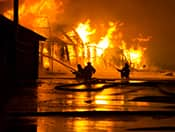Hazardous Materials in Factories
Factories handling hazardous materials often play a pivotal role in various industries, from chemical manufacturing to energy production. While these materials are indispensable for specific processes, they also pose a significant threat. A minor mishap or neglect in handling can transform these factories into a potential tinderbox.
Hazardous Materials and Fire Damage
The peril of fire damage looms large over factories dealing with hazardous materials. Flammable substances, when mishandled or exposed to unforeseen circumstances, can ignite, leading to catastrophic consequences. The aftermath of a fire in such a facility extends beyond the immediate financial loss, impacting operations, livelihoods, and the environment.
Understanding Fire Insurance
In the face of such risks, fire insurance emerges as a critical shield. Fire insurance policies are designed to provide financial protection against losses resulting from fire damage. However, the efficacy of such coverage depends on the specific terms and conditions outlined in the policy. It is crucial for factories to choose a policy that aligns with the nature of their operations and the types of hazardous materials involved.
Case Scenario: Mitigating Losses with Fire Insurance
Consider the case of Mr. Arjun Sharma, the owner of a chemical manufacturing unit in Mumbai, India. His factory dealing with volatile materials used in the production of specialty chemicals fall victim to an accidental fire. The flames engulfed the production area, causing significant damage to the machinery and infrastructure.
Fortunately, Mr. Sharma had foresight and had secured a comprehensive fire insurance policy tailored to his factory's specific needs. The policy covered the financial losses incurred due to the fire, including damage to the factory premises, machinery, and raw materials. This insurance cushion not only facilitated the timely reconstruction of the factory but also ensured the continuity of Mr. Sharma's business without bearing the full brunt of the financial blow.
Conclusion
In the intricate dance between industrial progress and potential hazards, factories dealing with hazardous materials walk a tightrope. Fire insurance emerges as a vital safety net, providing financial protection against the unpredictable ravages of fire. As industries evolve and hazardous materials continue to be integral to various processes, the judicious choice of fire insurance becomes a strategic imperative – a firewall against financial ruin in the event of an unforeseen inferno.

































 Expert advice made easy
Expert advice made easy


